| B-35 | |
|---|---|
 | |
| Role | Fighter |
| Manufacturer | Avia |
| Designer | František Novotný |
| First flight | 28 September 1938 |
| Number built | 3 |
The Avia B-35 (RLM designation Av-35) was a fighter aircraft built in Czechoslovakia shortly before World War II.
| B-35 | |
|---|---|
 | |
| Role | Fighter |
| Manufacturer | Avia |
| Designer | František Novotný |
| First flight | 28 September 1938 |
| Number built | 3 |
The Avia B-35 (RLM designation Av-35) was a fighter aircraft built in Czechoslovakia shortly before World War II.
The B.35 was designed to meet a 1935 requirement by the Czechoslovakian Air Force for a replacement for their B-534 fighter biplanes. The B.35 was an elegant, low-wing monoplane with an elliptical wing. The fuselage was constructed from welded steel tube, covered in metal ahead of and including the cockpit and fabric aft of the cockpit, while the wing was of entirely wooden construction. Rather anachronistically, the Air Force specified a fixed tailwheel undercarriage for the aircraft, in the hope that this would speed development, as the mechanism for retracting the undercarriage was not yet available. [1]
The first prototype, the B-35/1, displayed excellent flying characteristics and high speed and was originally powered by a Hispano-Suiza 12Ydrs piston engine. The powerplant was later changed to a 12Ycrs with an identical power output, but with provision for an autocannon to be fitted between the cylinder banks to fire through the propeller hub. Testing continued until 22 November 1938, when the aircraft was destroyed in a crash that killed the Military Technical and Aeronautical Institute test pilot Arnošt Kavalec. [2] Nevertheless, a second prototype, B-35/2, was already reaching completion, and was fitted with redesigned ailerons and flaps. It first flew on 30 December with testing beginning in earnest in February 1939. A preproduction series of ten aircraft was ordered, but before these could be built, Czechoslovakia was occupied by Germany in March 1939.
Development however was resumed under German control, with the substantially revised B.35/3 flying in August 1939. The elliptical leading edges of the wings had been replaced with straight ones, and an outward-retracting main undercarriage was fitted. This prototype was the first to actually carry its intended armament. With German markings and the registration D-IBPP, it was displayed at the Salon de l'Aéronautique [ clarification needed ] in Brussels, where enough interest was generated to spur development of an improved version of the aircraft as the B.135. [3]

General characteristics
Performance
Related development
Aircraft of comparable role, configuration, and era

The Dewoitine D.500 was an all-metal, open-cockpit, fixed-undercarriage monoplane fighter aircraft designed and produced by French aircraft manufacturer Dewoitine.

The Hispano-Suiza 12Y was an aircraft engine produced by Hispano-Suiza for the French Air Force before the Second World War. The 12Y became the primary French 1,000 hp (750 kW) class engine and was used in a number of famous aircraft, including the Morane-Saulnier M.S.406 and Dewoitine D.520.
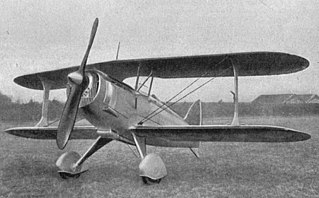
The Blériot SPAD S.510 was a French single-seat, single-engined biplane fighter aircraft. First flying in 1933, 60 were built for the Armée de l'Air, entering service in 1936. The type remained in service as a fighter-trainer at the start of the Second World War. It was the last French biplane fighter to enter production.
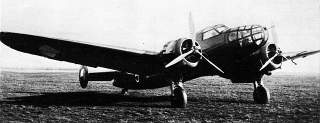
The Aero A.300 was a Czechoslovak bomber aircraft that first flew in 1938 as a much refined development of the A.304. It was designed by Aero to meet a requirement for a bomber-reconnaissance aircraft for the Czechoslovak Air Force, the Aero A-304 transport/bomber formed the basis for its design. It was a four-seat aircraft powered by two Bristol Mercury IX radial engines. The A-300 was faster than any other Czechoslovak aircraft in the inventory except for the Avia B-35 fighter. Despite showing much promise, development and production of the aircraft was stopped by the German occupation of Czechoslovakia.

The Tupolev ANT-40, also known by its service name Tupolev SB and development co-name TsAGI-40, was a high speed twin-engined three-seat monoplane bomber, first flown in 1934. The Tupolev design was advanced but lacked refinement, much to the dismay of crews, maintenance personnel, and Stalin, who pointed out that "there are no trivialities in aviation".

The Avia BH-21 was a fighter biplane designed and produced by the Czechoslovakian aircraft manufacturer Avia. First flown in January 1925, it served an important role in securing Czechoslovak national security during the Interwar period.
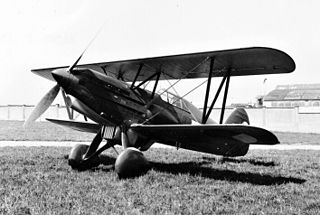
The Avia B-534 is a Czechoslovak biplane fighter developed and manufactured by aviation company Avia. It was produced during the period between the First World War and the Second World War. The B-534 was perhaps one of the most well-known Czechoslovakian aircraft of the era.

The Avia B.135 was a Czechoslovak cantilever monoplane fighter aircraft. It was the production version of the Avia B.35 developed shortly before the war, based on the B.35/3 prototype but featuring a new all-metal wing.

The Avia B-34 was a biplane fighter aircraft built in Czechoslovakia in the early 1930s. It was the first design of František Novotný for the Avia company and although built only in small numbers, it paved the way for the Avia B-534.
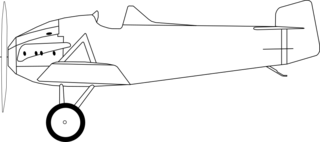
The Avia BH-4 was a prototype fighter aircraft built in Czechoslovakia in 1922. It was a development of the BH-3 fitted with a Hispano-Suiza 8 engine in an attempt to improve the aircraft's performance. To accommodate the new powerplant, the forward fuselage was considerably redesigned, and the structure in general and undercarriage in particular were strengthened. Performance was found to be only marginally better than the BH-3, and development was quickly abandoned.
The PZL.48 Lampart (leopard) was a Polish heavy fighter-bomber design, that remained only a project, owing to the outbreak of World War II.

The EKW C-36 was a Swiss multi-purpose combat aircraft of the 1930s and 1940s, built by the Eidgenoessische Konstruktionswerkstaette. It was a single-engined monoplane with a crew of two. It entered service during World War II in 1942, and despite being obsolete, remained in front line use until the early 1950s, and as a target tug until 1987.
The Beardmore W.B.IV was a British single-engine biplane ship-based fighter of World War I developed by Beardmore. Only one was built.

The SNCASE SE.100 was a French two-seat, twin-engined fighter that first flew in 1939. Mass production was planned to begin late in 1940 but the Fall of France prevented this.
The Latécoère 570 was a twin-engined medium bomber designed to a 1934 specification. It did not fly until 1939, by which time competitor aircraft had gone into service.
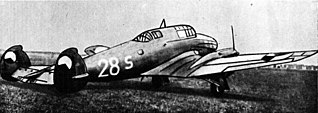
The Avia B.158 was a prototype Czechoslovak twin-engined light bomber aircraft of the 1930s. Only a single example was built and it was abandoned, following the German occupation of Czechoslovakia in March 1939.
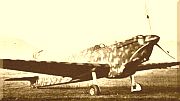
The Caproni Ca.335 Maestrale (Mistral) was an Italian single-engined two-seat fighter-bomber/reconnaissance aircraft of the 1930s.

PZL P.8 was a Polish fighter aircraft designed by Zygmunt Puławski, from the family of fighters with Polish wing, developed and produced by Państwowe Zakłady Lotnicze (PZL) in the early 1930s.

The Loire-Nieuport 161 was a single-seat, single-engine, all-metal, low-wing monoplane fighter designed and built in France in 1935 to compete for a government contract. Accidents delayed its development and only three prototypes were completed.

The Hanriot HD.15 was a French two-seat fighter aircraft fitted with a supercharger for good high altitude performance, built in the 1920s. Three were ordered by Japan but lost at sea during delivery.